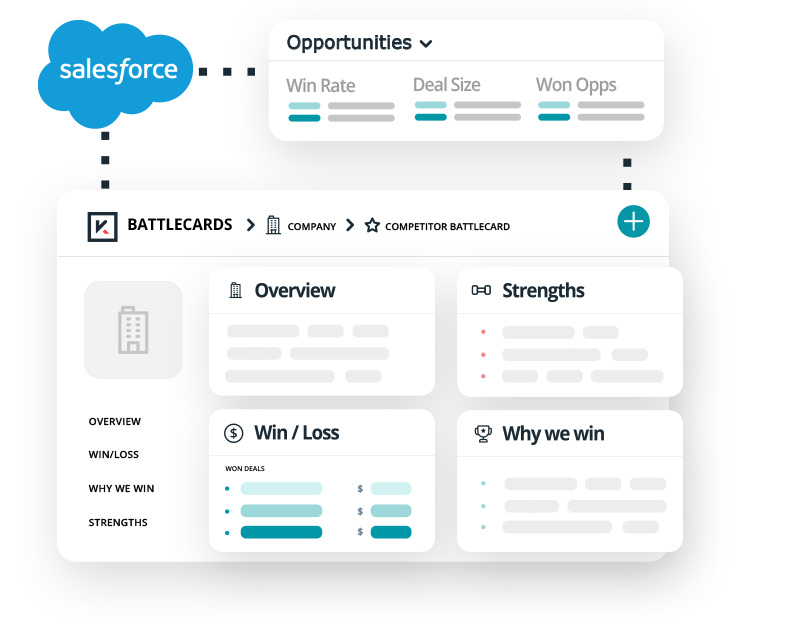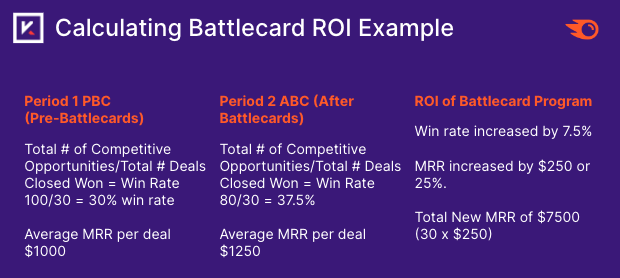Increased win rates, larger deal sizes, and a unified, more successful sales team.
That’s exactly what you were hoping for when you implemented your Battlecard program, right? You’ve done the hard part of compiling your intel, getting buy-in, and encouraging adoption. But how do you know if your Battlecard program is working? And if it is, how can you improve your results even more?
What Are Sales Battlecards?
Sometimes called playbooks or cheat sheets, a Battlecard is a reference that helps a salesperson prepare for a call and serves as a reference during calls, highlighting important information required to answer questions, overcome objections, and position your product as the best choice.
Battlecards may be updated manually and stored in a shared folder in Google, Dropbox, or other location. Or they can be updated both manually and with automation like Kompyte, and stored in a central location but available inside sales tools your team is already using (think HubSpot or Salesforce).
Kompyte Battlecards are easily accessible from Salesforce
Useful Battlecards are short, with concise insights written in sales-ready language, frequently updated (no one likes to be caught off guard in a sales call), and easily shared. The more useful they are, the easier it will be to get your sales team to adopt them!
We found that our customers averaged an up to 30% increase in win rate when they started using Battlecards, so the potential impact of a successful Battlecard program can be well worth the effort.

What Should a Sales Battlecard Include?
On a competitor-based sales Battlecard you might expect to find the following information related to your competitors:
- Company overview
- Product overview
- Product comparison
- Pricing
- Unique features
- “Kill” points (where you win)
- Strengths and weaknesses
On a sales Battlecard for your own company, you might include:
- Company overview
- Product features
- Ideal customer persona
- Pain points you address
- Pricing
- Unique features
- Top objections (and how to overcome them)
- Strengths and weaknesses
- Common sales objections
- Competitor talking points
- Use case examples or case studies
Get our free Battlecard template, complete with step-by-step instructions.

How to Measure the Success of Your Sales Battlecards
The short answer is - compare your sales metrics before you started using Battlecards to those same metrics after. Your sales cycle will determine how much time you’ll require to start seeing impact. You might be comparing total revenue, win/loss rate, cycle length, or something else.
Here’s a simple example:

Kompyte integrates with CRMs to calculate this for you. An added advantage is that you can see, not just before and after Battlecards were implemented, but a comparison of results when Battlecards were actually used versus not. And as we all know, adoption can be one of the biggest challenges in sales enablement and Battlecard programs. This kind of analysis can help convince your sales team that they are worth using.

It's even better when your Win/Loss Analysis shows the impact of actually using the Battlecards.
Another, less scientific way but still important way to measure success is to evaluate how supported and happy your sales representatives report feeling. You can ask directly with a survey, in one-on-one conversations, or using eNPS (employee net promoter score). Make sure to ask questions related to implementation of Battlecards, whether they are using them, and what would make them more useful.
How to Improve the ROI of your Sales Battlecards
Keep them up to date. Good communication with your product team will help you keep your Battlecards up to date for features and benefits. Be sure to adjust for new messaging, too. Take advantage of automation options if available.

Kompyte Battlecards show when sections were last updated. Make sure to do the same on yours.
Keep them easily accessible. A sticky note on a monitor does not count as a Battlecard. 🙂 One of the goals of your Battlecard program is that your sales processes are repeatable and consistent. To that end, careful version control and easy access is key. How do you make sure everyone is working from the same version of your Battlecard? Keep only one available and discourage reps from sharing them to their computers or printing out copies. You can do this in Dropbox, Google Drive, or any file sharing program.
Ideally you make them available in the sales tools your team is already using. Kompyte's Battlecards are accessible right inside HubSpot and Salesforce.
Get your hands dirty. Ask sales leaders to connect you with underperforming reps. Find out where their struggles are. Are they using Battlecards? Is there something you could do to make them more useful? Listen to sales calls. Where are people getting stuck? What are reps saying to close the deal that might not yet be on your Battlecards?
Write the way they talk. Is your Battlecard copy written in corporate speak? Don’t ask your salespeople to translate into casual sales call conversations - put it in the Battlecard the way they want to say it.
Increase adoption. This may be the most impactful and most difficult method of improving Battlecard ROI. Using your analysis, can you prove a higher win rate when Battlecards are used? Turn those numbers into increased commission to motivate reps to use them too. Or make a game out of it. The rep who uses Battlecards in the highest percentage of sales calls wins a prize.
Once your sales team uses Battlecards, finds them helpful, and gets used to them, you’ll just need to keep them up to date to keep them coming back. Watch our on-demand webinar about increasing Battlecard adoption with tips from both a Product Marketing Manager and a Sales Director.
Next Steps for Measuring and Improving the ROI of Sales Battlecards
Once your Battlecard program is up and running, make sure it’s working to help increase consistency and sales by comparing important metrics before and after Battlecard adoption. You should also look for progress in areas such as communication between internal teams and sales team job satisfaction.
When you spot areas for improvement, don’t delay, as making and keeping your Battlecards useful is the key to enjoying an up to 30% increase in win rates. That’s something your sales team can get excited about!
